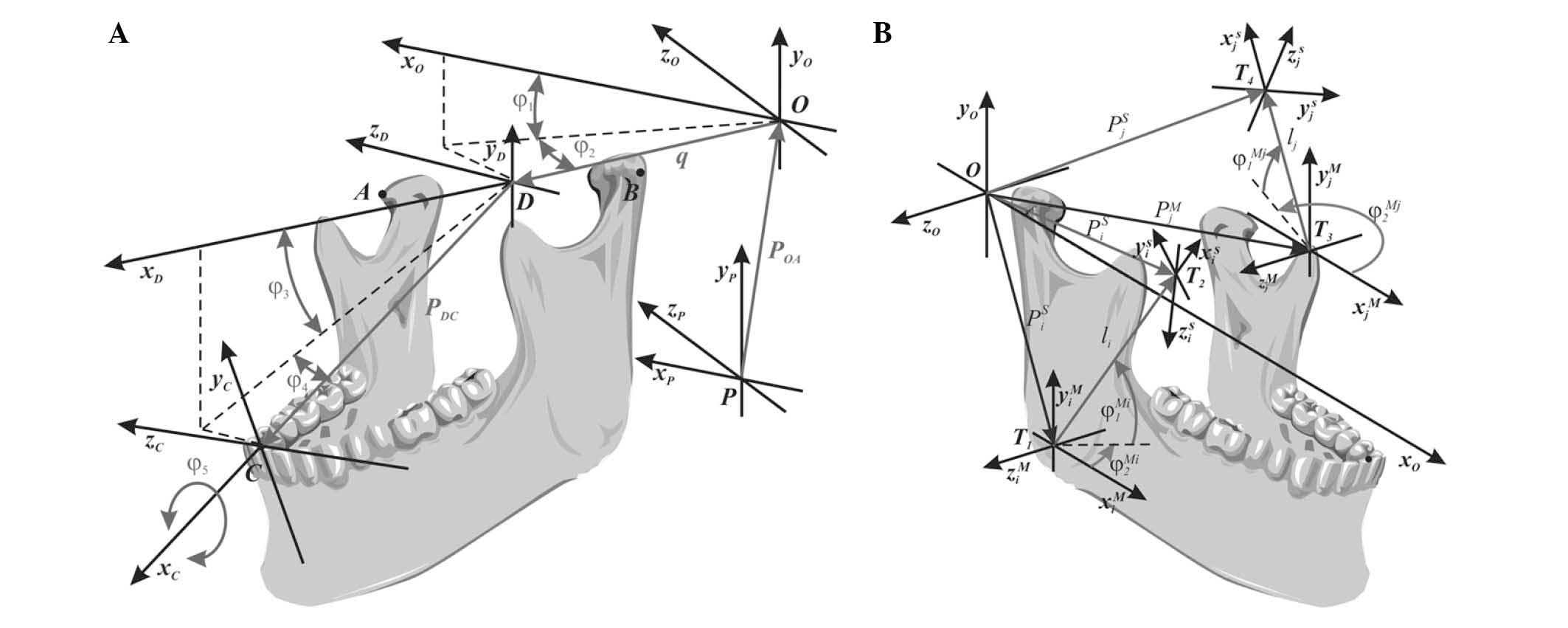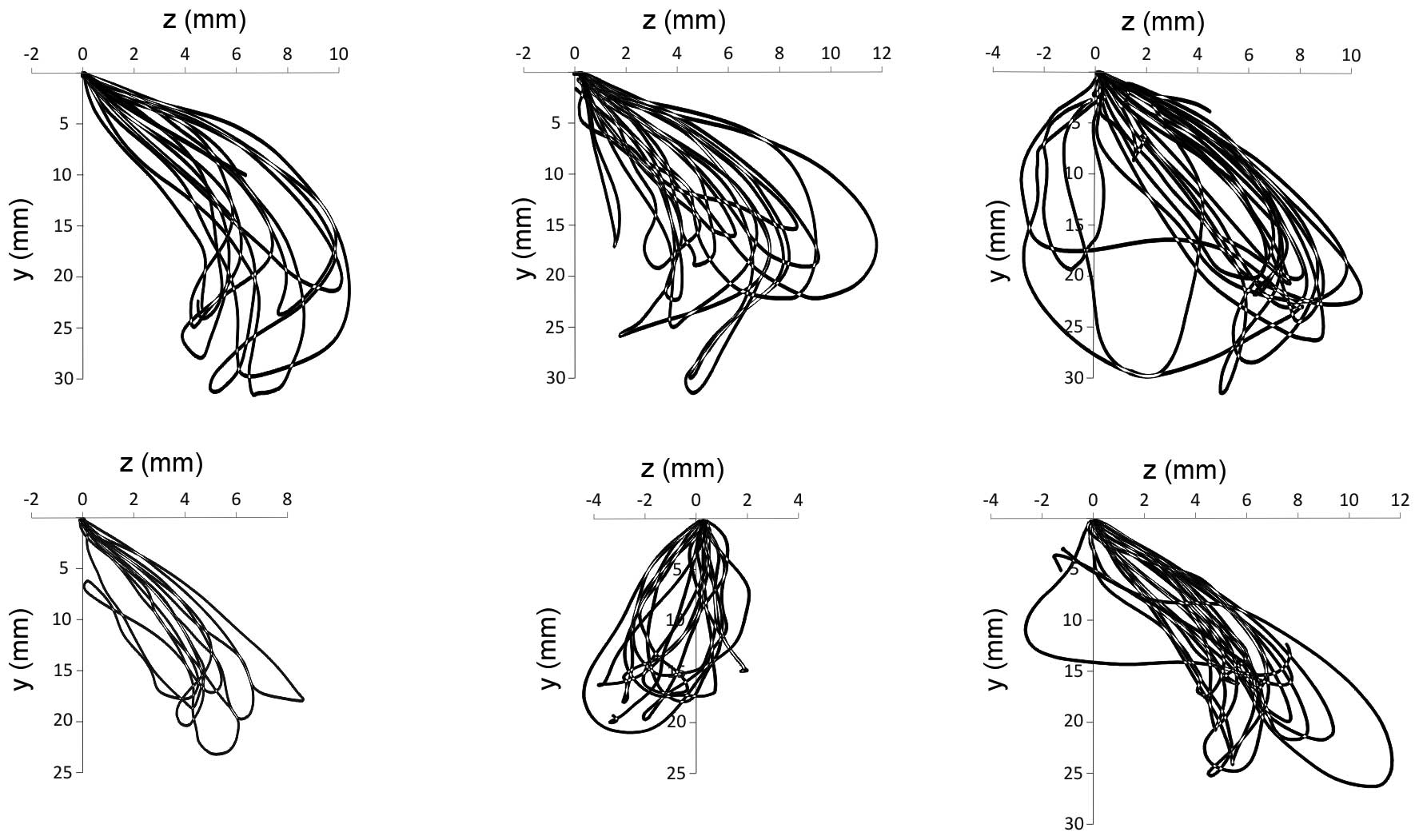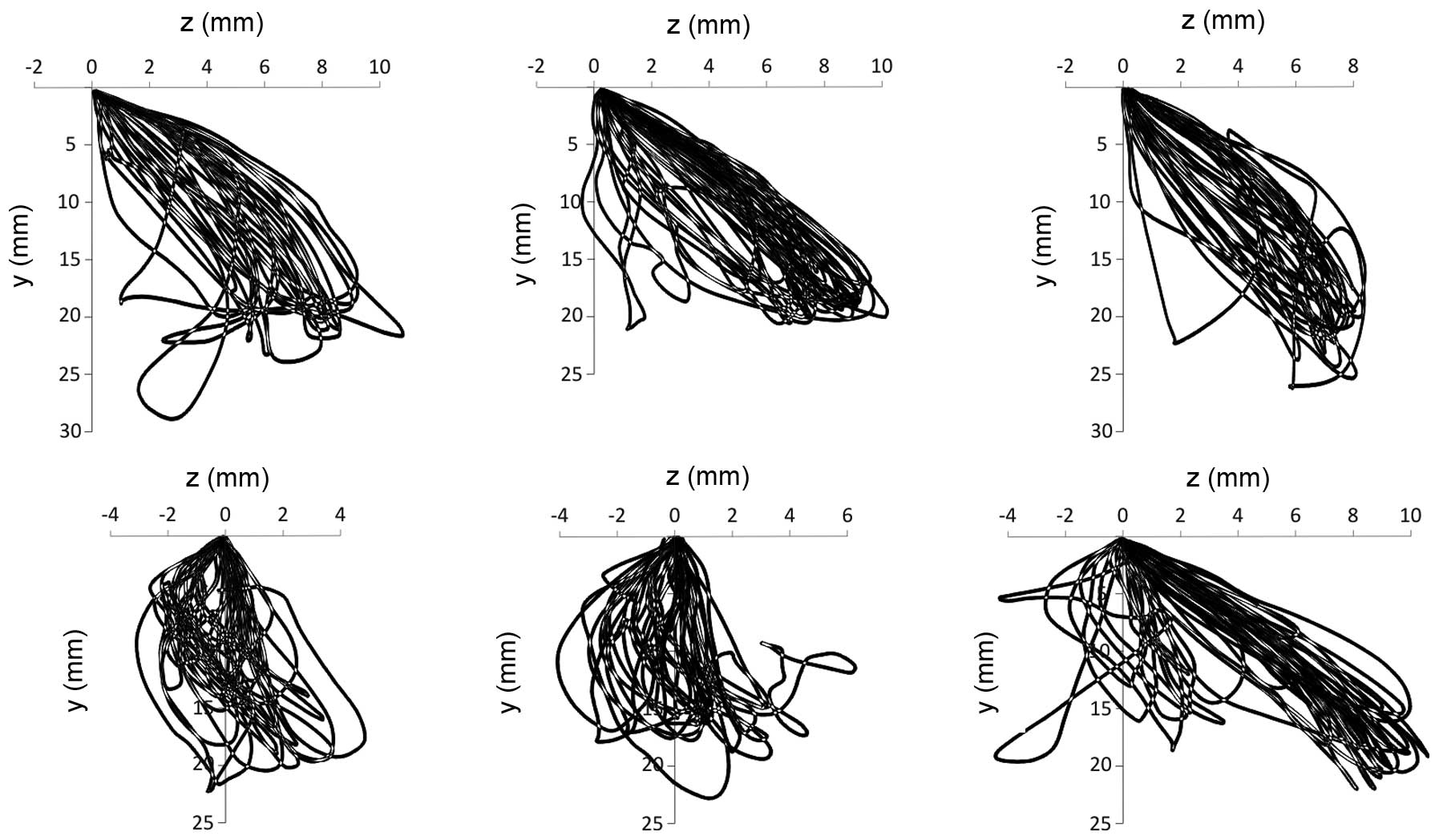|
1
|
Okeson JP: Neuroanatomy and physiology of
the masticatory locomotor system from the functional sideManagement
of temporomandibular disorders and occlusion. 1. 5th. Mosby
Elsevier; St. Louis, MO: pp. 40–48. 2005
|
|
2
|
Ahlgren J: Mechanism of mastication. Acta
Odontol Scand. 24:(Suppl 44). 1–109. 1966.
|
|
3
|
Wickwire NA, Gibbs CH, Jacobson AP and
Lundeen HC: Chewing patterns in normal children. Angle Orthod.
51:48–60. 1981.PubMed/NCBI
|
|
4
|
Gibbs CH, Messerman T, Reswick JB and
Derda HJ: Functional movements of the mandible. J Prosthet Dent.
26:604–620. 1971. View Article : Google Scholar : PubMed/NCBI
|
|
5
|
Gibbs CH and Lundeen HC: Jaw movement and
forces during chewing and swallowing and their clinical
significanceGibbs CH and Lundeen HC: Advances in occlusion. John
Wright-PSG, Inc; Littleton, Mass: 1. pp. 2–32. 1982
|
|
6
|
Miyaoka Y, Ashida I, Iwamori H, Kawakami
S, Tamaki Y, Yamazaki T and Ito N: Synchronization of masseter
activity patterns between the right and left sides during chewing
in healthy young males. J Med Eng Technol. 38(1-5): 2812014.
View Article : Google Scholar : PubMed/NCBI
|
|
7
|
Crane EA, Rothman ED, Childers D and
Gerstner GE: Analysis of temporal variation in human masticatory
cycles during gum chewing. Arch Oral Biol. 58:1464–1474. 2013.
View Article : Google Scholar : PubMed/NCBI
|
|
8
|
Slavicek G, Soykher M, Soykher M, Gruber H
and Siegl P: Relevance of a standard food model in combination with
electronic jaw movement recording on human mastication pattern
analysis. Advances in Bioscience and Biotechnology. 1:68–78. 2010.
View Article : Google Scholar
|
|
9
|
Ogawa T, Ogawa M and Koyano K: Different
responses of masticatory movements after alteration of occlusal
guidance related to individual movement pattern. J Oral Rehabil.
28:830–841. 2001. View Article : Google Scholar : PubMed/NCBI
|
|
10
|
Mongini F and Tempia-Valenta G: A graphic
and statistical analysis of the chewing movements in function and
dysfunction. J Craniomandib Pract. 2:125–134. 1984. View Article : Google Scholar
|
|
11
|
Hashii K, Tomida M and Yamashita S:
Influence of changing the chewing region on mandibular movement.
Aust Dent J. 54:38–44. 2009. View Article : Google Scholar : PubMed/NCBI
|
|
12
|
Henrikson T, Ekberg EC and Nilner M:
Masticatory efficiency and ability in relation to occlusion and
mandibular dysfunction in girls. Int J Prosthodont. 11:125–132.
1998.PubMed/NCBI
|
|
13
|
Youssef RE, Throckmorton GS, Ellis E and
Sinn DP: Comparison of habitual masticatory cycles and muscle
activity before and after orthognathic surgery. J Oral Maxillofac
Surg. 55:699–707. 1997. View Article : Google Scholar : PubMed/NCBI
|
|
14
|
English JD, Buschang PH and Throckmorton
GS: Does malocclusion affect masticatory performance? Angle Orthod.
72:21–27. 2002.PubMed/NCBI
|
|
15
|
Slavicek G: Human mastication.
International journal of stomatology & occlusion medicine.
3:29–41. 2010. View Article : Google Scholar
|
|
16
|
Kim BI, Jeong SH, Cho KH, Chung YK, Kwon
HK and Choi CH: Subjective food intake ability in relation to
maximal bite force among Korean adults. J Oral Rehabil. 36:168–175.
2009. View Article : Google Scholar : PubMed/NCBI
|
|
17
|
Proeschel P: An extensive classification
of chewing patterns in the frontal plane. Cranio. 5:55–63. 1987.
View Article : Google Scholar : PubMed/NCBI
|
|
18
|
Pröschel P and Hofmann M: Frontal chewing
patterns of the incisor point and their dependence on resistance of
food and type of occlusion. J Prosthet Dent. 59:617–624. 1988.
View Article : Google Scholar : PubMed/NCBI
|
|
19
|
Miyauchi S, Nakaminami T, Nishio K and
Maruyama T: Chewing pattern in posterior crossbite. Classification
of chewing pattern in the frontal plane. Nippon Hotetsu Shika
Gakkai Zasshi. 33:938–951. 1989.(In Japanese). View Article : Google Scholar : PubMed/NCBI
|
|
20
|
Dan H and Kohyama K: Interactive
relationship between the mechanical properties of food and the
human response during the first bite. Arch Oral Biol. 52:455–464.
2007. View Article : Google Scholar : PubMed/NCBI
|
|
21
|
Reed DA and Ross CF: The influence of food
material properties on jaw kinematics in the primate, Cebus. Arch
Oral Biol. 55:946–962. 2010. View Article : Google Scholar : PubMed/NCBI
|
|
22
|
Anderson K, Throckmorton GS, Buschang PH
and Hayasaki H: The effects of bolus hardness on masticatory
kinematics. J Oral Rehabil. 29:689–696. 2002. View Article : Google Scholar : PubMed/NCBI
|
|
23
|
Horio T and Kawamura Y: Effect of texture
of food on chewing patterns in the human subject. J Oral Rehabil.
16:177–183. 1989. View Article : Google Scholar : PubMed/NCBI
|
|
24
|
Van Der Bilt A, Engelen L, Abbink J and
Pereira LJ: Effects of adding fluids to solid foods on muscle
activity and number of chewing cycles. Eur J Oral Sci. 115:198–205.
2007. View Article : Google Scholar : PubMed/NCBI
|
|
25
|
Shiozawa M, Taniguchi H, Hayashi, Hori,
Tsujimura, Nakamura, Ito K and Inoue M: Differences in chewing
behavior during mastication of foods with different textures. J
Text Stud. 44:44–45. 2013. View Article : Google Scholar
|
|
26
|
Wintergerst AM, Throckmorton GS and
Buschang PH: Effects of bolus size and hardness on within-subject
variability of chewing cycle kinematics. Arch Oral Biol.
53:369–375. 2008. View Article : Google Scholar : PubMed/NCBI
|
|
27
|
Lundeen HC and Gibbs CH: Jaw movements and
forces during chewing and swallowing and their clinical
significanceAdvances in occlusion. 1. 5th. John Wright-PSG Inc.;
Bristol: pp. 2–32. 1982
|
|
28
|
Horio T and Kawamura Y: Effects of texture
of food on chewing patterns in the human subject. J Oral Rehabil.
16:177–183. 1989. View Article : Google Scholar : PubMed/NCBI
|
|
29
|
Jankelson D, Hoffman GM and Hendron AJ:
The psysiology of the stomatognathic system. The Journal of the
American Dental Association. 46:375–386. 1952. View Article : Google Scholar : PubMed/NCBI
|
|
30
|
Anderson DJ and Picton DC: Tooth contact
during chewing. J Dent Res. 36:21–26. 1957. View Article : Google Scholar : PubMed/NCBI
|
|
31
|
Ahlgren J: Mechanism of mastication; a
quantitative cinematographic and electromyographic study of
masticatory movements in children with special reference to
occlusion of the teeth. Acta Odontolologica Scandinavica. 44:44–45.
1966.
|
|
32
|
Adams SH and Zander HA: Functional tooth
contacts in lateral and centric occlusion. J Am Dent Assoc.
69:465–473. 1964. View Article : Google Scholar : PubMed/NCBI
|
|
33
|
Martin R and Saller K: Textbook of
anthropology in systematic representation with special emphasis on
anthropological methods. Fischer Publishing Company; 3. Stuttgart:
1957
|
|
34
|
Ichim I, Kieser JA and Swain MV:
Functional significance of strain distribution in the human
mandible under masticatory load: Numerical predictions. Arch Oral
Biol. 52:465–473. 2007. View Article : Google Scholar : PubMed/NCBI
|
|
35
|
Bérzin F: Surface electromyography in the
diagnosis of syndromes of the cranio-cervical pain. Braz J Oral
Sci. 10:484–491. 2004.
|
|
36
|
Coelho-Ferraz MJP, Bérzin F and Amorim C:
Electromyography Evaluations of the masticator muscles during the
maximum bite force. Revista Espanola de Cirugia Oral y
Maxilofacial. 6:420–427. 2008.
|
|
37
|
Koolstra JH: Dynamics of the human
masticatory system. Crit Rev Oral Biol Med. 13:366–376. 2002.
View Article : Google Scholar : PubMed/NCBI
|
|
38
|
Castroflorio T, Icardi K, Becchino B,
Merlo E, Debernardi C, Bracco P and Farina D: Reproducibility of
surface EMG variables in isometric sub-maximal contractions of jaw
elevator muscles. J Electromyogr Kinesiol. 16:498–505. 2006.
View Article : Google Scholar : PubMed/NCBI
|
|
39
|
Santana-Mora U, Cudeiro J, Mora-Bermúdez
MJ, Rilo-Pousa B, Ferreira-Pinho JC, Otero-Cepeda JL and
Santana-Penín U: Changes in EMG activity during clenching in
chronic pain patients with unilateral temporomandibular disorders.
J Electromyogr Kinesiol. 19:e543–e549. 2009. View Article : Google Scholar : PubMed/NCBI
|
|
40
|
Liu F and Steinkeler A: Epidemiology,
diagnosis and treatment of temporomandibular disorders. Dent Clin
North Am. 57:465–479. 2013. View Article : Google Scholar : PubMed/NCBI
|
|
41
|
Karibe H, Goddard G, Aoyagi K, Kawakami T,
Warita S, Shimazu K, Rudd PA and McNeill C: Comparison of
subjective symptoms of temporomandibular disorders in young
patients by age and gender. Cranio. 30:114–120. 2012. View Article : Google Scholar : PubMed/NCBI
|
|
42
|
Zimmer B: Correlations between the loss of
acoustic TMJ symptoms and alterations in mandibular advancement.
Eur J Orthod. 15:229–234. 1993. View Article : Google Scholar : PubMed/NCBI
|
|
43
|
Motoyoshi M, Matsumoto Y, Ohnuma M,
Arimoto M, Takahashi K and Namura S: A study of temporomandibular
joint sounds. Part 2. Acoustic characteristics of joint sounds. J
Nihon Univ Sch Dent. 37:47–54. 1995. View Article : Google Scholar : PubMed/NCBI
|
|
44
|
Prinz JF: Autocorrelation of acoustic
signal from the temporomandibular joint. J Oral Rehabil.
25:635–644. 1998. View Article : Google Scholar : PubMed/NCBI
|
|
45
|
Roda R Poveda, Bagan JV, Fernandez JM
Diaz, Hernández Bazán S and Jiménez Soriano Y: Review of
temporomandibular joint pathology. Part I. Classification,
epidemiology and risk factors. Med Oral Patol Oral Cir Bucal.
12:E292–E298. 2007.PubMed/NCBI
|
|
46
|
Vanderas AP and Papagiannoulis L:
Multifactorial analysis of the aetiology of craniomandibular
dysfunction in children. Int J Paediatr Dent. 12:336–346. 2002.
View Article : Google Scholar : PubMed/NCBI
|
|
47
|
Chladek W: System of modeling the selected
mechanical states of human mandible. Scientific Papers of Silesian
University of Technology. 59:1082000.(In Polish).
|
|
48
|
Zhang X, Ashton-Miller JA and Stohler CS:
Three-dimensional unilateral method for the bilateral measurement
of condylar movements. J Biomech. 28:1007–1011. 1995. View Article : Google Scholar : PubMed/NCBI
|
|
49
|
Zuccari AG, Andres CJ and Simpson GW: A
color-enhanced aid for location of the transverse horizontal
opening and closing axis of the mandible. J Prosthet Dent.
76:181–186. 1996. View Article : Google Scholar : PubMed/NCBI
|
|
50
|
Peck CC, Murray GM, Johnson CW and
Klineberg IJ: Trajectories of condylar points during nonworking
side and protrusive movements of the mandible. J Prosthet Dent.
82:322–331. 1999. View Article : Google Scholar : PubMed/NCBI
|
|
51
|
Osborn J and Baragar F: Predicted pattern
of human muscle activity during clenching derived from a computer
assisted model: Symmetric vertical bite force. J Biomech.
18:599–612. 1985. View Article : Google Scholar : PubMed/NCBI
|
|
52
|
Korioth TW and Hannam AG: Deformation of
the human mandible during simulated tooth clenching. J Dent Res.
73:56–66. 1994. View Article : Google Scholar : PubMed/NCBI
|
|
53
|
Meyer C, Kahn JL, Lambert A, Boutemy P and
Wilk A: Development of a static simulator of the mandible. J
Craniomaxillofac Surg. 28:278–286. 2000. View Article : Google Scholar : PubMed/NCBI
|
|
54
|
Peck CC, Langenbach GE and Hannam AG:
Dynamic simulation of muscle and articular properties during human
wide jaw opening. Arch Oral Biol. 45:963–982. 2000. View Article : Google Scholar : PubMed/NCBI
|
|
55
|
Sellers WI and Crompton RH: Using
sensitivity analysis to validate the predictions of a biomechanical
model of bite forces. Ann Anat. 186:89–95. 2004. View Article : Google Scholar : PubMed/NCBI
|
|
56
|
Peck CC and Hannam AG: Human jaw and
muscle modeling. Arch Oral Biol. 52:300–304. 2007. View Article : Google Scholar : PubMed/NCBI
|
|
57
|
Liu ZJ, Yamagata K, Kasahara Y and Ito G:
Electromyographic examination of jaw muscles in relation to
symptoms and occlusion of patients with temporomandibular joint
disorders. J Oral Rehabil. 26:33–47. 1999. View Article : Google Scholar : PubMed/NCBI
|
|
58
|
Al-Saleh M, Armijo-Olivo S, Flores-Mir C
and Thie N: Electromyography in diagnosing temporomandibular
disorders. J Am Dent Assoc. 143:351–362. 2012. View Article : Google Scholar : PubMed/NCBI
|
|
59
|
Manfredini D, Cocilovo F, Favero L,
Ferronato G, Tonello S and Guarda-Nardini L: Surface
electromyography of jaw muscles and kinesiographic recordings:
Diagnostic accuracy for myofascial pain. J Oral Rehabil.
38:791–799. 2011. View Article : Google Scholar : PubMed/NCBI
|
|
60
|
Ferrario VF, Sforza C, Colombo A and Ciusa
V: An electromyographic investigation of masticatory muscles
symmetry in normo-occlusion subjects. J Oral Rehabil. 27:33–40.
2000. View Article : Google Scholar : PubMed/NCBI
|
|
61
|
Leader JK, Boston J, Debski R and Rudy T:
Mandibular kinematics represented by a non-orthogonal floating axis
joint coordinate system. J Biomech. 36:275–281. 2003. View Article : Google Scholar : PubMed/NCBI
|
|
62
|
Daumas B, Xu WL and Bronlund JE: Jaw
mechanism modelling and simulation. Mech Mach Theory. 7:821–833.
2005. View Article : Google Scholar
|
|
63
|
Slavicek G and Schimmer C: Analysis of
human mastication behavior: a new approach using planar
calculations of fragmented chewing sequences. International journal
of stomatology & occlusion medicine. 3:61–67. 2010. View Article : Google Scholar
|
|
64
|
Hayashi K, Mizoguchi I, Lee SP and Reich
B: Development of a novel statistical model for mandibular
kinematics. Med Eng Phys. 32:423–428. 2010. View Article : Google Scholar : PubMed/NCBI
|
|
65
|
Slavicek G, Soykher M, Gruber H, Siegl P
and Oxtoby M: A novel standard food model to analyze the individual
parameters of human mastication. International journal of
stomatology & occlusion medicine. 2:163–174. 2009. View Article : Google Scholar
|
|
66
|
Χie D, Xu WL, Foster KD and Bronlund J:
Object-oriented knowledge framework for modelling human mastication
of foods. Expert Systems with Applications. 36:4810–4821. 2009.
View Article : Google Scholar
|
|
67
|
Hannam AG, Stavness I, Lloyd JE and Fels
S: A dynamic model of jaw and hyoid biomechanics during chewing. J
Biomech. 41:1069–1076. 2008. View Article : Google Scholar : PubMed/NCBI
|
|
68
|
Pond LH, Barghi N and Barnwell GM:
Occlusion and chewing side preference. J Prosthet Dent. 55:498–500.
1986. View Article : Google Scholar : PubMed/NCBI
|
|
69
|
Tanne K, Tanaka E and Sakuda M: The
elastic modulus of the temporomandibular joint disc from adult
dogs. J Dent Res. 70:1545–1548. 1991. View Article : Google Scholar : PubMed/NCBI
|
|
70
|
Chin LP, Aker FD and Zarrinnia K: The
viscoelastic properties of the human temporomandibular joint disc.
J Oral Maxillofac Surg. 54:315–318; discussion 318–319. 1996.
View Article : Google Scholar : PubMed/NCBI
|
|
71
|
Lai WF, Bowley J and Burch JG: Evaluation
of shear stress of the human temporomandibular joint disc. J Orofac
Pain. 12:153–159. 1998.PubMed/NCBI
|
|
72
|
Tanaka E, Shibaguchi T, Tanaka M and Tanne
K: Viscoelastic properties of the human temporomandibular joint
disc in patients with internal derangement. J Oral Maxillofac Surg.
58:997–1002. 2000. View Article : Google Scholar : PubMed/NCBI
|
|
73
|
Tanaka E, Tanaka M, Jattori Y, Aoyama J,
Watanabe M, Sasaki A, Sugiyama M and Tanne K: Biomechanical
behaviour of bovine temporomandibular articular disc with age. Arch
Oral Biol. 46:997–1003. 2001. View Article : Google Scholar : PubMed/NCBI
|
|
74
|
Tanaka E, Tanaka M, Miyawaki Y and Tanne
K: Viscoelastic properties of canine temporomandibular joint disc
in compressive load-relaxation. Arch Oral Biol. 44:1021–1026. 1999.
View Article : Google Scholar : PubMed/NCBI
|
|
75
|
Throckmorton GS, Groshan GJ and Boyd SB:
Muscle activity patterns and control of temporomandibular joint
loads. J Prosthet Dent. 63:685–695. 1990. View Article : Google Scholar : PubMed/NCBI
|
|
76
|
Di Palma E, Gasparini G, Pelo S, Tartaglia
GM and Chimenti C: Activities of masticatory muscles in patients
after orthognathic surgery. J Craniomaxillofac Surg. 37:417–420.
2009. View Article : Google Scholar : PubMed/NCBI
|
|
77
|
Di Palma E, Gasparini G, Pelo S, Tartaglia
GM and Sforza C: Activities of masticatory muscles in patients
before orthognathic surgery. J Craniofac Surg. 21:724–726. 2010.
View Article : Google Scholar : PubMed/NCBI
|



















